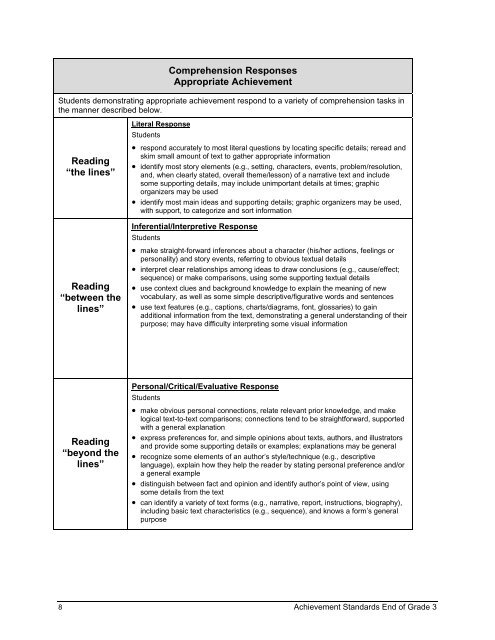Reading and Writing Achievement Standards Curriculum
Reading and Writing Achievement Standards Curriculum
Reading and Writing Achievement Standards Curriculum
You also want an ePaper? Increase the reach of your titles
YUMPU automatically turns print PDFs into web optimized ePapers that Google loves.
Comprehension Responses<br />
Appropriate <strong>Achievement</strong><br />
Students demonstrating appropriate achievement respond to a variety of comprehension tasks in<br />
the manner described below.<br />
Literal Response<br />
Students<br />
<strong>Reading</strong><br />
“the lines”<br />
• respond accurately to most literal questions by locating specific details; reread <strong>and</strong><br />
skim small amount of text to gather appropriate information<br />
• identify most story elements (e.g., setting, characters, events, problem/resolution,<br />
<strong>and</strong>, when clearly stated, overall theme/lesson) of a narrative text <strong>and</strong> include<br />
some supporting details, may include unimportant details at times; graphic<br />
organizers may be used<br />
• identify most main ideas <strong>and</strong> supporting details; graphic organizers may be used,<br />
with support, to categorize <strong>and</strong> sort information<br />
Inferential/Interpretive Response<br />
Students<br />
<strong>Reading</strong><br />
“between the<br />
lines”<br />
• make straight-forward inferences about a character (his/her actions, feelings or<br />
personality) <strong>and</strong> story events, referring to obvious textual details<br />
• interpret clear relationships among ideas to draw conclusions (e.g., cause/effect;<br />
sequence) or make comparisons, using some supporting textual details<br />
• use context clues <strong>and</strong> background knowledge to explain the meaning of new<br />
vocabulary, as well as some simple descriptive/figurative words <strong>and</strong> sentences<br />
• use text features (e.g., captions, charts/diagrams, font, glossaries) to gain<br />
additional information from the text, demonstrating a general underst<strong>and</strong>ing of their<br />
purpose; may have difficulty interpreting some visual information<br />
Personal/Critical/Evaluative Response<br />
Students<br />
<strong>Reading</strong><br />
“beyond the<br />
lines”<br />
• make obvious personal connections, relate relevant prior knowledge, <strong>and</strong> make<br />
logical text-to-text comparisons; connections tend to be straightforward, supported<br />
with a general explanation<br />
• express preferences for, <strong>and</strong> simple opinions about texts, authors, <strong>and</strong> illustrators<br />
<strong>and</strong> provide some supporting details or examples; explanations may be general<br />
• recognize some elements of an author’s style/technique (e.g., descriptive<br />
language), explain how they help the reader by stating personal preference <strong>and</strong>/or<br />
a general example<br />
• distinguish between fact <strong>and</strong> opinion <strong>and</strong> identify author’s point of view, using<br />
some details from the text<br />
• can identify a variety of text forms (e.g., narrative, report, instructions, biography),<br />
including basic text characteristics (e.g., sequence), <strong>and</strong> knows a form’s general<br />
purpose<br />
8 <strong>Achievement</strong> St<strong>and</strong>ards End of Grade 3
















